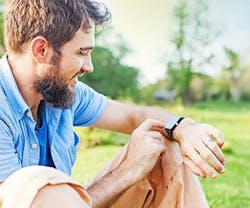When did wearables become cool? Was it when we watched people walk down the street appearing to be talking to themselves when utilizing Bluetooth technology? The fitness craze of the Fitbit that lead to questions like “how many steps did you do today?” or “have you done your 10,000 steps?” Entire water-cooler conversations have developed based solely on feedback that has been received from technology, comparing wearables, and the latest versions of devices.
In the past, it was not always acceptable to wear a bracelet if you were a resident in a long term care setting and were considered an elopement risk. Now, wearing a Fitbit is considered normal and hip—not only being able to count your steps, but unobtrusively provide data on a person’s vitals—heart rate, pulse, blood pressure, glucose levels and a host of other unique information that provide a basis for health and wellness decisions. The data can be gathered without having to physically examine or move a person to any type of clinical space; unless there is a reason for an intervention, a resident can continue on with their daily routine and chosen activities. For residents with dementia, this can avoid unnecessary or undesired interaction, providing a positive outcome, but still collecting valuable health and wellness data.
During CE Week (Consumer Electronics Week) in NYC, a FashionWare Runway Show was part of the Wearables Techzone. Top designers produced their latest couture for wearable technology. Technology is not only functional, but reaching new heights as a fashion statement—geek meets international design—resulting in aesthetically beautiful and highly functional.
BauBax, known for creating lifestyle apparel, announced their launch of Wireless Charging Apparel. The impact to nursing and other frontline staff in hospitals and long term care settings could allow all types of wireless devices to be used that were once “tethered” because of limited battery life. Other than the need to be cautious around different equipment (MRIs), and electronically sensitive equipment or implants, this idea could be a game changer in the healthcare marketplace.
During CE Week, one of the Technovation Awards went to FUSAR, an action sports-based company that created Mohawk, a smart helmet system that transforms any helmet into an action camera, activity tracker, communication device, navigation unit, music player, black box and emergency alert system! Wow—that would be a system that could give a resident or patient full control of their world, including access to staff. Next step would be to be able to use the same technology in a different type of wearable: perhaps a hat, a pair of socks, or a piece of jewelry that could still perform all of the tasks. This could literally revolutionize the nurse call industry and provide a tracker for those with dementia that included audible cues.
Robin Raskin, founder of Living in Digital Times, reported in the Huffington Post on wearables that reflect the needs of the summer–including a product called Soltrackr, which is a small device that attaches to a key fob or carabiner. Through a Bluetooth connection, a smartphone can provide instructions on balancing sun exposure and vitamin D production—being that most older adults have vitamin D deficiencies, this information could assist with caring for elders. If we could couple this with Ayo, who has developed a special pair of glasses to reduce jet lag by using a blue-light that helps adjust hormone levels, there could be a technological intervention and collaboration for helping residents and patients to re-set their circadian rhythms and receive adequate sunlight for vitamin D production. Both are needs for people with dementia and sufferers of Sundowners Syndrome. The time is right to be looking at wearables used or proposed in industries outside of healthcare that could result in an evidence-based application that supports positive outcomes for patients, residents, and staff.
Many of the latest technology innovations are on websites that include a crowd funding option or a ‘pre-order’ opportunity—using the upfront sales toward the production costs of the wearables. Support is high for wearable technology—Zenta is a bracelet wearable that measures just about anything that impacts the balance of the mind and body. They have been featured on Fast Company, CNN, Forbes, and The New York Times and have raised $215,723 raised by 1023 backers—216 percent of their $100,000 goal!
Established companies, like Under Armor are evaluating “smart fabrics” as a way to provide all of a person’s vitals and feedback. If a resident or patient was not capable or did not choose to wear an accessory, it could be possible for the fabric itself to allow for transmission of information.
The first time one of my colleagues started talking into her watch, I thought she’d been watching Dick Tracey re-runs or had fallen into the resurgence of super hero comics! The smart watch replaced the smart phone as a fashion accessory with full ability to receive email, telephone calls, write texts, and monitor her calendar. The evolution of technology is so fast, the Zenta has far surpassed the capabilities of her watch and her Fitbit. Technology for the hearing impaired used to be discussed as a novelty—that jewelry could be worn that would include aides and devices to improve an individual’s hearing. No longer a novelty, with the introduction of Bluetooth technology there has been a revolutionized approach to improving technology for those with hearing impairment; creating affordable solutions for those with a wide range of hearing issues to improve their quality of life; going far beyond the Miracle Ear. With the theme song in my head from The Jetsons: “meet George Jetson, Jane, his wife, daughter, Judy, his son, Elroy”; along with Astro and Rosie, would all be very proud that many of the futuristic amenities found in the famous television series are improving lives on a regular basis for people around the world—and for all we know E.T. and the gang are also benefitting!
Jane Rohde is the founding Principal of JSR Associates, Inc. located in Ellicott City, Maryland. She champions a global cultural shift toward de-institutionalizing senior living and healthcare facilities through person-centered principles, research and advocacy, and design of the built environment. Clientele includes nonprofit and for-profit developers, government agencies, senior living and health care providers, and design firms. Jane speaks internationally on senior living, aging, healthcare, evidence based design and sustainability. She is the first recipient of the Environments for Aging Changemaker Award presented by The Center for Health Design. For more information or comments, please contact Jane Rohde at [email protected].
About the Author

Jane Rohde
AIA, FIIDA, ASID, ACHA, CHID, LEED AP BD+C, GGA-EB
Jane Rohde, AIA, FIIDA, ASID, ACHA, CHID LEED AP BD+C & GGA – EB: Jane Rohde is the founding principal of JSR Associates Inc. in Catonsville, MD. JSR Associates Inc. celebrates 23 years of consulting services in 2019. Jane is the recipient of the 2015 Environments for Aging Changemaker Award and in 2018 she received the ASID Design for Humanity Award, was recognized as an Honorary Alumni of Clemson University’s Architecture + Health program, and has been honored as one of 10 notable Women in Design. For more information or comments, please contact Jane Rohde at [email protected] or “Chat with Jane” at www.jsrassociates.net.
